FSAC on Tour: Caverns, Blue Holes & a Wreck
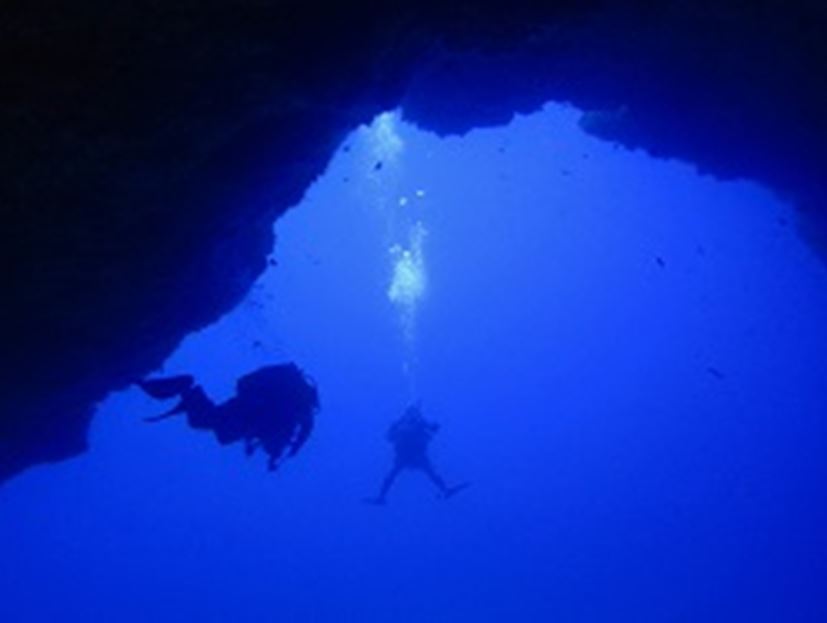
I had last seen a cavern on my trip to Florida and Ginny Springs in April 2004, Jason McNamara, one of my Divemasters had been living in Lanzarote for a year or so by then. Jason had returned on a family holiday with his girlfriend Nerina summer of ’04 and got talking about the diving there and had me interested, there were a couple of wrecks that were worth looking at and a couple of caverns too. It didn’t take me long to turn interest into another trip for FSAC and for my family, a little Canary Island Sun would not hurt anyone, especially in a UK Autumn likely to be close to zero degrees and wet with it! There were three of the club up for a dive break too, Tracy, Rob & Jim, all Nitrox students, and considering it would be a second break that year, Ellen was ok with it becoming an “official” dive trip that she and the boys would tag onto, just to enjoy the warmer weather and somewhere different. We managed to get decent accommodation behind Playa Blanca (away from the party area) in a nice little complex with a decent pool for Ellen & the boys and just down the road from some nice little back street restaurants for the evenings. The dive centre that would help us out and provide the RIB’s and gas mixes was Calipso Diving in Costa Teguise run by Jason & Nerina’s Dive Boss Peter
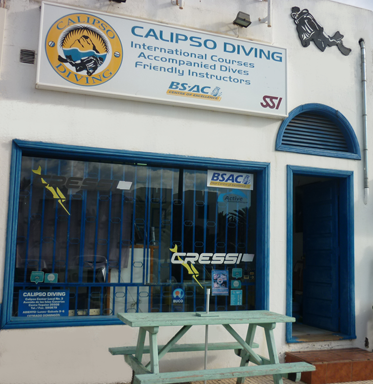
I have to say Lanzarote was not a destination I would have usually chosen as a holiday, the Canaries had something of a reputation for being “party” destinations and that was never going to be my idea of fun. It took Jason & Nerina some time to convince me there was a better side to the Islands than expected, and that the diving was good too, the flight time helped too, and there was plenty for Ellen & the lads so if the diving was as good as Jason & Nerina said then we’d all be happy! Once we had settled into the apartment’s and looked around the complex a bit I was happier, the boys were delighted with the pool, Ellen was happy and the rooms were great, well away from the 24/7 crowd too, not that we wouldn’t drop down to the harbour and its bars, but far enough away that we could spend some quieter time too….. We logged in with Calipso too, to get the kit sorted for the first dive which would be a wreck, the Rabat, a modern Seine Net fishing trawler that had failed to make it to dock sinking in 32m just off Arrecife
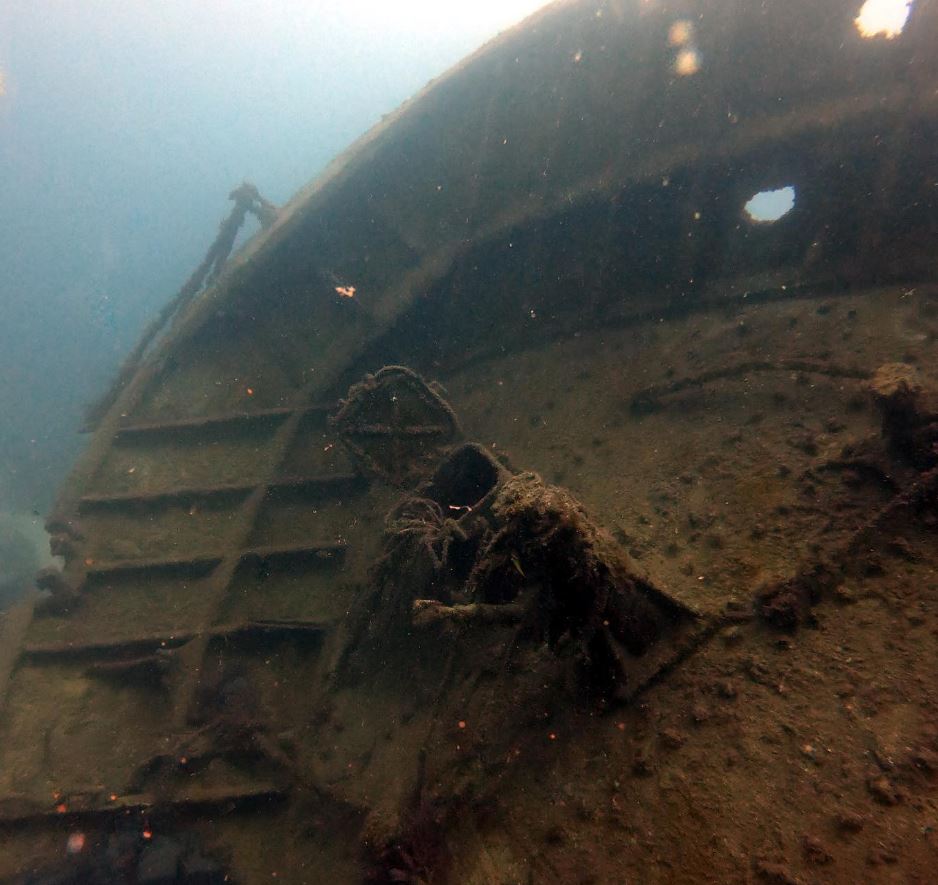
The Rabat was one of the fishing boats used to harvest the North African Seas around Cape Juby, fitted with freezer capabilities to facilitate longer and more productive trips, and a part of the Spanish economic boom of the 1960’s. The Franco Government had introduced programmes to encourage the ownership of bigger, more modern trawlers to improve the Spanish fishing fleets, and financed some of the purchase costs. Those larger vessels made their home ports in the Canaries and were operated largely by Galician fishing families who migrated South to the Canaries to take advantage of the Saharan coastal fish shoals (Meltzoff S. K. & Lipuma E. “the troubled seas of Spanish fishermen: marine policy and the economy of change” University of Miami Press Online Resource: https://anthrosource.onlinelibrary.wiley.com/doi/pdf/10.1525/ ae.1986.13.4.02a00060 Accessed: 13/02/2022) The increase in foreign fishing, especially in regards to Spanish fleets became controversial in the 1970’s and countries like Morocco, the prime North African coastline the Canary Island fleets had enjoyed, began to protect their waters from Spanish fleets. Although when we dived the Rabat it was said to have “floundered as it tried to return to port”, it is now generally believed to have been scuttled by a disgruntled owner who could fish an ever decreasing area and was seeing greatly reduced catches as a result
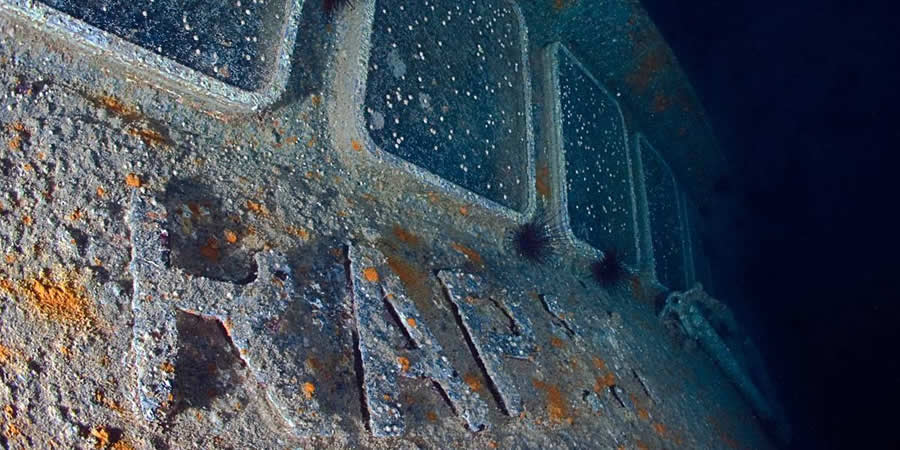
My Green Navy Log recorded: “23/10/04 LANZAROTE The Rabat Wreck This is a fishing trawler which didn’t make it back into port. 10 mins from the harbour modern vari-speed props & wholly intact on it’s port side. Shot at stern & we fought a bit of a current to descend & look round the props, along a little at max depth & then into the stern via a hatch & through the hold area to see the nets still in place. Out of the deck hatch & along to the bridge which we cut up through, front glass still in place. Plenty of Amberjack & wonderful little crab-shrimp beautifully coloured – shoals of small silver fish. Back out along the starboard hull & up to the shot for the safety stop Air In 230 Out 100 32% Nitrox Mix Buddy Jim Leigh”

The Rabat was another one of those great dives spoiled somewhat by the likely method of sinking, although nothing could be certain, it takes the edge off a wreck dive when you suspect it has been an insurance job, sunk surreptitiously. It still is far removed from the placing of hulls deliberately to entice divers and I enjoyed the Rabat wreck on that basis, deliberate sinking had never been proven, just suspected………
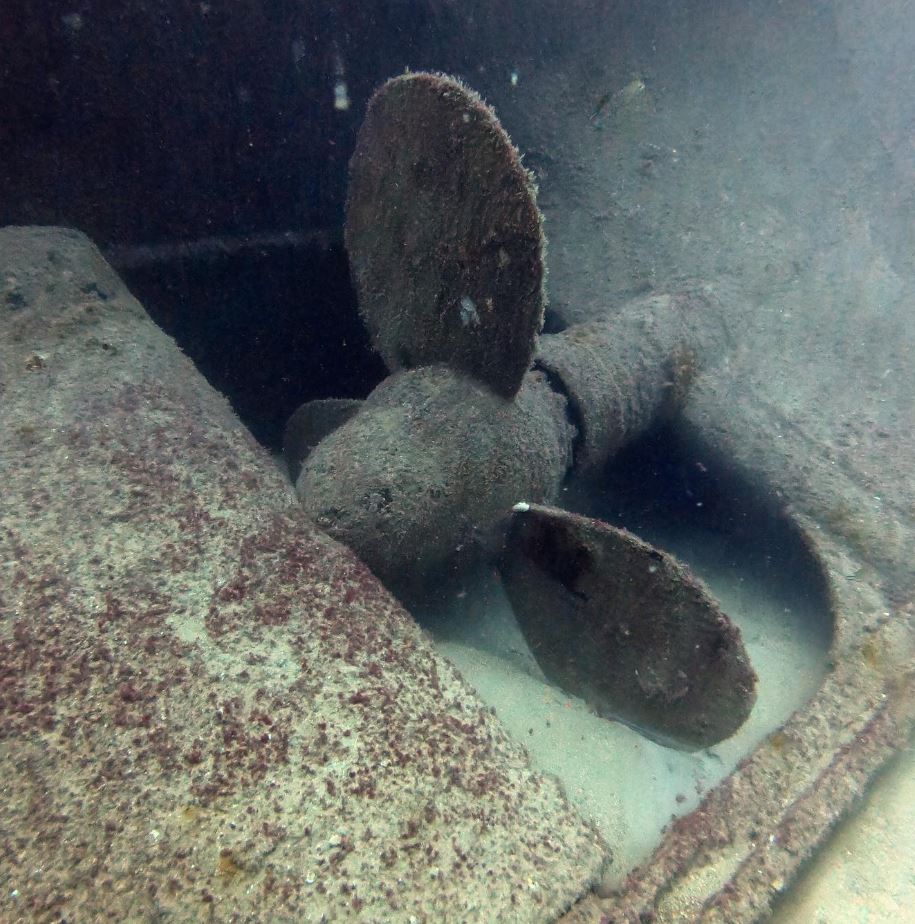
Our next dive was to be one Jason had talked about often, one of his favourites called the Blue Eyes or depending on whose dive centre you were with, Skull Cave. I think it opportune to point out that Lanzarote is a volcanic island, obvious to those of you who have perhaps visited Timanfaya Park, but not so to those who have not I rather suppose! Timanfaya is an active volcanic biosphere, named after the volcano that created it, Timanfaya volcano, it is well worth a visit and can easily be reached by car, or one of the numerous tours bookable at any of the island’s resorts, I was determined the family would get to see it and the divers wanted to come along too
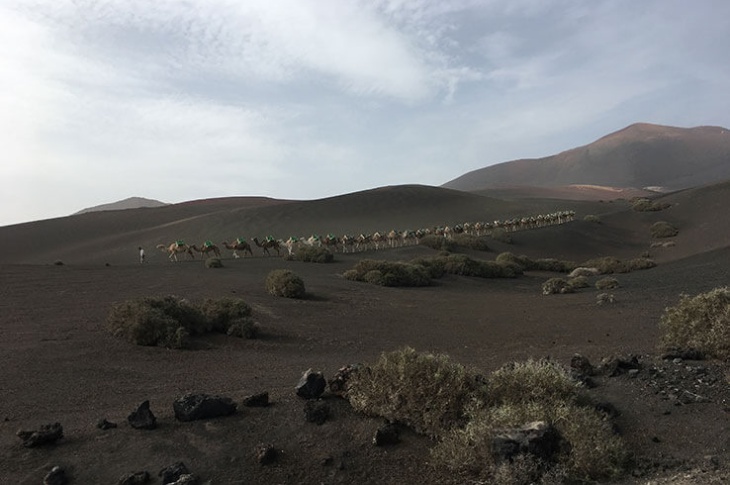
Ellen and I chose to get the kids there over the last mile or so by Camel, an easy ride in makeshift seats carrying several people either side on one animal, a far different affair than my last Camel ride in Tunisia where I was on my own, but then the boys were only 10 or 12 at the time so the seats were a better bet. The park shows many different features of a volcanic landscape from unusual Sulphurous smells, to BBQ’s over volcanic vents, and steam plumes escaping on regular occasions, giving a very surreal landscape which they enjoyed enormously, well worth a visit too. However the descriptive is only to illustrate the underwater features of the island’s coast as Lanzarote is pock-marked by volcanic vents which originate from lava tubes that have spewed out the rising molten rock, leaving behind the empty and sometimes collapsed tubes for those of a mind to explore, both on land and underwater around the coastline. Those lava vents are what forms the caverns and caves of the underwater terrain of Lanzarote, and it is to those we descend next
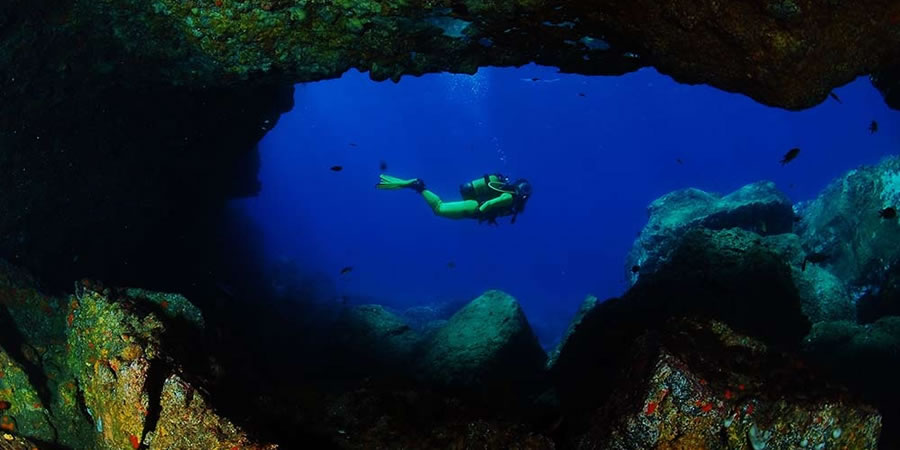
Calipso had arranged for us to take several of the cave and cavern dives as shore dives and provided us with a dive guide to ensure we got the right entry and exit, and a decent truck for the gear, as a couple of the drop-off points would be local tracks to make the swims shorter, the log records: “25/10/04 LANZAROTE Blue Eyes/Skull Caves. Long swim out to the cave with plenty of colourful fish with a very large Ray in the sand which took off as if “on cue” beautiful! A shoal of Barracuda with many fish just to our right & then into the cave from 14m to 30 a narrow entrance which has several “windows” allowing light in, then into the main chamber full of nooks & crannies & air wells down a narrow hallway to exit from the Skull’s left eye. Very nice dive. Off back to deco through the ascent & climb out up the shore rock plateau. Nitrox 32% Air In 200 Out 60 Buddy Jim Leigh” The cavern diving on Lanzarote is nothing particularly challenging, there is light visible throughout, and the diving is excellent for the tourist diver who wants a little more than rock sand and the occasional colourful fish. The other side of the caverns is the lure that they have, the almost imperceptible temptation to want to see beyond the light, to go further into the dark places, I was beginning to understand the title of Martyn Farr’s caving book “The Darkness Beckons”
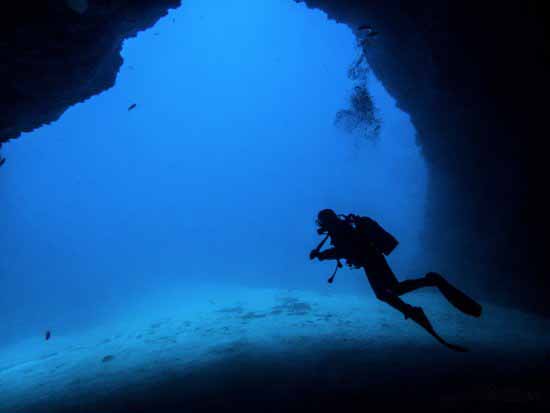
Our next dive would be the Cathedral, a local feature of the volcanic vents perhaps, either way, a huge cavern mouth in the rock face at 30m or so to the sand, so a deeper dive for those getting used to using Nitrox. All three students were taking the transition in their strides, Tracy, Jim & Rob were enjoying it too, the overall feeling reported was nothing dramatic, just a clearer feeling on the dive and less fatigue than previously. Pointing out the safer aspect of equivalent air depth calculations for dive times, and the better Oxygenation in circulation just rounded off the experience I think, the more enjoyable experience of being in clear, warm Blue water was not lost on them either, Stoney Cove is a great training environment but the cold experienced in 4’ water can easily call longer dive-times into question….especially in winter
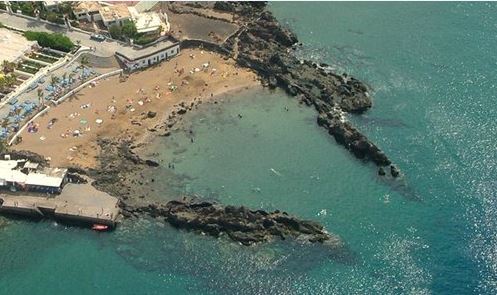
Most of the diving in Lanzarote is shore diving, I’m not worried how I get to a dive site as long as the diving is good, I’m not convinced that the reason shore diving is more prevalent is the fees for RIB hire the dive-shops would incur, or the cost of buying dive-RIBs, but whatever, you go with the flow where you must! Another trip out in the 4 x 4 with our gear following in the truck and we reached the headland and our entry point at Playa Chica (which I believe translates as beach girl), with two pronounced rock headlands sticking out into the sea either side of the beach itself, the log book records: “26/10/04 LANZAROTE “The Cathedral” a huge overhang which housed soft corals and plenty of small fish all really beautifully coloured. One large grouper resident and another out to the far side of the overhang. Plenty of sea slugs & fish on the swim back & a strong current to fight too Nitrox 32 Air In 200 Out 70 Buddy Jim Leigh” I recall humping the dive kit down to the entry point on the rocks was a little challenging, volcanic rock is pretty abrasive stuff, you wouldn’t want to take a fall, so care is needed! The issue with shore diving that does warrant some discussion is dive pricing, as we are all aware, RIB diving can be expensive, it’s not unreasonable for the main, as dive-centres would go out of business if it were, but it is pricey. Shore diving abroad doesn’t seem that much cheaper, there is the transport and local knowledge of the entry & exit points, and the actual sites themselves, but be cautious, there are plenty of options in most areas, check what you are getting, one dive guide between 4 divers often is not sufficient, especially in caves, or if two buddy pairs don’t breathe at similar rates…….

The Blue Hole is probably the best known dive on Lanzarote, it even features on PADI’s web site, which should indicate how popular the dive is to those visiting the Canaries. It is the best of the lava tube dives available to untrained cavern enthusiasts and tourist divers alike and the longest, the entry is close to the one used for the Cathedral, by Playas Chicas, but off the pier itself, my log entry for the dive reads: “27/10/04 LANZAROTE “Blue Hole” Playa Del Carmen 10’ giant stride from the pier then a choppy swim over & a descent & swim past huge shoals of fish including a large shoal of Barracuda up to about 3’ long. Drop down to 45m at a rock pinnacle & then back up & through the blue hole which is a decent swim through from 30m to 18m full of soft corals. great dive. Air In 250 Out 160 buddy Jim Leigh” I liked this dive most, although each had its high points and was good in different ways, the Blue Hole was a decent length swim through and there was a shaft of brilliant light you could see at the end, where the funnel meets the plateau of the sea bed above you leading back to the beach. I didn’t mention the bubbles escaping from the porous lava rock of the plateau, or the Eel garden we swam over on the way back, perhaps the main of the swim through distracted me, but I do remember these points but did not note them at the time
As ever, this post would be nothing without the pictures, I’d like to thank those who have contributed, Calipso Diving, Manta and especially Matthew Williams (Matt32) for kind permission to use his excellent shots of the Rabat Wreck
